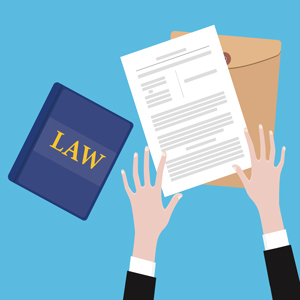
Let’s say you go to the bookstore to buy your next book club selection. You find a hardbound edition of the novel and thumb through it. As you walk to the checkout, you spy a paperback in the discount bin. You have to squint to read the small font, and the words seem to bleed together. So you drop it back in the bin, opting to spend the extra money on the hardbound copy. The font is easier to read and the visual design draws you in. You read the first chapter in the checkout line.
Despite the identical content of the two editions, you picked one over the other because it was easier to read. After comparing the editions, you noticed how the hardbound edition’s typography – the visual presentation of the words on the page – was easier to comprehend. And comprehension is something you value. After all, you want to sound smart leading the book club discussion.
Briefs are the legal profession’s novels – and judges are its bibliophiles. Lay readers, lawyers, and judges all notice when something is difficult to read, and all get distracted from the text by poor visual presentation. But all also are pleasantly drawn into text that uses good typography, which aids reader comprehension. “[A]n effectively designed document,” says law professor James Dimitri, “make[s] the arguments in the document more memorable to the reader” and “make[s] a strong statement to the reader about the authoring attorney’s credibility.”1
To that end, brief writers should aim to make their visual presentation as pleasing as possible. Those who do will gain an upper hand over their opponent. The Seventh Circuit agrees: “You can improve your chances by making your briefs typographically superior. It won’t make your arguments better, but it will ensure that judges grasp and retain your points with less struggle. That’s a valuable advantage, which you should seize.”2 If two briefs contain the same content but one is easier to read, that one will be more persuasive.
To design a visually superior brief, you must comply with court rules and orders about formatting and typography. You might also have to follow conventions set by your employer. But these rules and conventions merely establish a floor: you should go beyond compliance. In this article, we share best practices and recommendations for doing so.
Rules of Appellate Procedure
We organize our discussion of best practices around Wis. Stat. section 809.19(8)(b), part of the Wisconsin Rules of Appellate Procedure, which sets forth basic typography standards for briefs filed in the Wisconsin Supreme Court and Wisconsin Court of Appeals.
At the same time, the rule grants brief writers substantial discretion to make typography choices. We explain what each rule requires and then offer additional recommendations for crafting a visually superior brief.
Later, we explain how our recommendations translate to filings in Wisconsin circuit courts and other tribunals. While our recommendations apply to brief writing generally, particular jurisdictions, courts, and judges may have their own preferences. The U.S. Court of Appeals for the Seventh Circuit, for example, maintains detailed typography standards.3
Paper Versus Screen
The Rules of Appellate Procedure were written with paper in mind. Although many judges still read briefs on paper, more and more are reading briefs electronically. Should you design your brief differently if it will be read electronically?
To be sure, paper and electronic screens lend themselves to different typographical best practices. With older technology, these differences were quite pronounced. For example, it is accepted wisdom that serif fonts look better on paper, but sans serif fonts look better on a screen.30
As screen technology continues to improve, however, many differences between paper and screens have evaporated. “[W]ith screens becoming more paper-like than ever, there’s decreasing need to make special accommodations for screen reading.”31 What’s more, judges who read on a screen typically view briefs in paginated PDF form, meaning what they see on a monitor, laptop, or tablet resembles paper.
All this means that you needn’t fret over the difference between paper and screens. That said, we have tailored our recommendations to work well both on paper and electronically.
Font Choice
A visually appealing brief starts with a visually appealing font. In Wisconsin appellate courts, “[b]riefs shall be produced by using either a monospaced font or a proportional serif font” in size 13 for body text and size 11 for footnotes and block quotes.4
A monospaced font’s characters all occupy the same width on the page; a proportional font’s characters vary in width. Monospaced fonts, such as Courier, are a vestige of early typewriters and are rarely used today. When writing a brief, you should always use a proportional font.
Under the rule, a proportional font must also include serifs. A “serif” is the small curl-like feature added to the ends of characters in certain fonts. For instance, Times New Roman and the font used in the Wisconsin Lawyer printed articles are serif fonts. Arial and Verdana are sans-serif fonts.
Brief writers have considerable discretion when choosing which proportional serif font to use. Yet the inertia of blind tradition has made Times New Roman the default and has led “[m]any lawyers [to] erroneously assume that courts demand” it.5
Times New Roman was invented in the early 20th century for the Times of London and quickly gained traction among newspaper publishers. The Times commissioned it as an intentionally narrow font to fit more text per line and to enable quick reading.6 Even from the beginning, it was criticized as unappealing to the eye.
For all its ubiquity in self-published documents, when was the last time you saw Times New Roman in a book? Maybe never. Fonts used in professionally published books are comparably easier to read. This visual appeal, in turn, fosters comprehension and retention.7
Because “[b]riefs are like books rather than newspapers,” we (along with courts and typographers) recommend using a book font to write briefs. Among the best proportional serif fonts are Century, Century Schoolbook, and Book Antiqua.8 These fonts are used by professional printers and the country’s best legal writers. The U.S. Supreme Court, for example, uses Century to publish its slip opinions.
Book fonts tend to take up more space on the page than Times New Roman does. The rule enforces a word count, however, not a page count. At least in Wisconsin appellate courts, you can’t gain an advantage by using a font that fits more words onto a page.
Spacing Choices
The space you leave on the page creates a sense of breathing room; a reader should not feel overwhelmed in approaching the print on the page. Creating the right spacing is a matter of both mathematics and art. The rule specifies that if you use a proportional serif font (see above), you must also use a “leading of minimum 2 points.”9
Leading (pronounced with a soft “e” like the metal “lead”) refers to “the vertical space from the same point on one line to the same point on the next, within the same paragraph.”10 The term originated with the small lead pieces used in hand typesetting to space vertical lines.11
Leading and “line spacing” are sometimes used interchangeably, but they are slightly different concepts.12 Line spacing is the “vertical distance between lines of text.”13
Single spacing is generally too cramped for the eye. Double spacing, historically used in term papers to allow for handwritten comments, slows down the eye and is therefore no longer recommended. It creates too much white space (or “negative space”) on the page, especially when paired with wider margins (see below).
Legal typography expert Matthew Butterick recommends using line spacing that is between 120 percent and 145 percent of the font size.14 When using Microsoft Word, this translates to 1.03-1.24 line spacing (not 1.2-1.45).15 That said, allowing some room for tradition and flexibility, selecting between 1.15 and 1.5 line spacing in the Word paragraph dialog box will promote optimal readability in a Wisconsin appellate brief.
If you use less than 1.25 line spacing, consider adding additional space between paragraphs. To comply with the rule and as a best practice, we recommend either 1.4 line spacing or 1.15 line spacing with extra spacing between paragraphs to give the reader’s eyes a break. Note that your choice of margin width may warrant a small adjustment to these figures (see below).
As to spacing between sentences on the same line, one space is sufficient for proportional fonts.16 This departs from past practice with typewriters and monospaced fonts, when two spaces were recommended to create a visual break.
The Future of the Rules of Appellate Procedure
All of Wis. Stat. chapter 809 is currently under review by the Appellate eFiling Committee, appointed by the Clerk of the Supreme Court and Court of Appeals to recommend rule changes for appellate electronic filing. The committee is considering changes to Wis. Stat. section 809.19(8) that may affect the recommendations in this article to some extent. Although their exact contours are not known with certainty, any changes will likely more closely reflect the best practices and recommendations discussed in this article.
A petition to recommend mandatory eFiling for attorneys filing in the Court of Appeals and Supreme Court is expected to be filed in autumn 2020.
Margins and Alignment
Typography entails not only the text itself, but also the text’s relationship to the page. To that end, decisions about margins and alignment significantly affect the visual appeal of a brief. The rule regulates a brief’s margins by mandating a “maximum of 60 characters per full line of body text.”17 The number of characters per line depends on the font. If you use size 13 Century Schoolbook, 60 characters amounts to roughly 1.5-inch margins.
By capping the number of characters, the rule sets a minimum margin width, which you can exceed. We recommend setting your margins between 1.5 and 2 inches. This range complies with what’s required and provides adequate white space. Like silent rests between the musical notes of a symphony, white space is crucial for a visually appealing and easy-to-read document.18
In general, the wider you set your margins (the more white space at the edges), the less white space you need between lines within the same paragraph. If you use 1.5-inch margins, for example, then 1.25 to 1.4 line spacing looks quite comfortable; if you use 2-inch margins, you can reduce your line spacing to as low as 1.15. (See also Spacing Choices, above.)
Closely related to margins is alignment. Microsoft Word allows you to left align or justify your text. Whereas the former lines up only the left edge of the text, the latter aligns “both the left and the right margins by adding additional space between words as needed.”19 The text of this article is left aligned.
Which alignment fosters easier reading?20 Left-aligned text leaves jagged right edges (called “rags”), which many view as unappealing. It has the advantage, however, of keeping uniform space between all words on the page.
Justified text, with its flush-right edge, “gives text a cleaner, more formal look.”21 But the reader’s eyes must contend with different-sized spaces between the words in each consecutive line. Sometimes the spaces become quite wide, causing “rivers”— “vertical flow[s] of white spaces that appear near each other on consecutive lines of text.”22 Inconsistent spacing and rivers make text more difficult to read, which reduces comprehension and retention.
Unless you’re engaging a professional typesetter (who has sophisticated technology for combatting rivers), we recommend sticking with left-aligned text. If you do justify, you should also hyphenate. In this context, hyphenation refers to splitting long words across lines at syllabic breaks.
Microsoft Word has a rudimentary automatic hyphenation function that controls for some of the inconsistent spacing endemic to justified text. You can select this option under the Layout -> Page Setup tab. (You may also have to adjust your Paragraph settings to undo the check box “Don’t Hyphenate.”)
Also of Interest

OnDemand Seminar
Improving Your Persuasion: Legal Typography & Citations
The judiciary and their staff have extremely heavy dockets and are bombarded with thousands of briefs each year. Consequently, seemingly small details like formatting and typography matter a great deal. In Improving Your Persuasion: Legal Typography and Citations, a State Bar of Wisconsin PINNACLE® OnDemand seminar, civil appellate litigator Dylan O. Drummond shares his best tips for holding readers’ attention spans and making your briefs more enjoyable to read, including:
- Reliable typography resources
- Basic citation forms
- Font suggestions
- Subtext speaks volumes
Failing to pay attention to the small details can lead your audience to question the bigger matters, that is, the accuracy and logic of your arguments. Make your briefs stand out because of the quality of your arguments — not because of their sloppy appearance — with tips and tricks from Improving Your Persuasion: Legal Typography and Citations.
State Bar of Wisconsin PINNACLE OnDemand seminar; members ($89), nonmembers ($139). 1 CLE credit.
Headings, Emphasis & Graphics
Good document design governs the use of headings and other visual aids to facilitate comprehension. The rule provides for the use of headings and adds that
“[i]talics may not be used for normal body text but may be used for citations, headings, emphasis and foreign words.”23
Headings draw attention to important points, helping a reader comprehend and retain information through a process called “chunking.”24 Although the rule allows you to italicize headings, italics and underlining impair readability in single-spaced headings.
To make the most of your headings, create contrast without being flashy. For briefs, we recommend using the same font and same size as the body text, though bolded for contrast. Capitalizing every word in a heading or using all caps or small caps is distracting. To enhance readability, capitalize only the first word and proper nouns. (Many non-brief publications use various different typography settings, all of which can look very good. For example, the Wisconsin Lawyer uses a non-serif font for subheads, bolded, initial capped, and left justified (as is all text), and uses a serif font for body text.)
Be sure to use consistent numbering and spacing in headings. Align your headings with the left margin of your paragraphs. Indent your subheadings (from the left) using the same amount of space as you use to indent each new paragraph. Exacting placement of headings in a document creates a professional look that conveys credibility. Also, consider using an introductory paragraph between a main heading and a subheading; headings should be followed by content.25
Italics are appropriate for citations, limited emphasis in text, and some foreign words. Avoid using underlining, all caps, or small caps in briefs; italics are the only acceptable way to add emphasis. Underlining is a product, again, of the bygone typewriter era.26
Like long headings, block quotations provide a visual wall of text that many readers skip over. When you do use them, sparingly, include only the most relevant language in the quote and use ellipses for internally omitted language and citations. Two shorter block quotes are preferable to one long block quote. We also recommend introducing the quote with language more meaningful than “the court said as follows.” Then go on to explain the quote in your own words.27
Finally, graphics and pictures can help a reader quickly draw inferences. Charts and bullet points synthesize material. Don’t hesitate to copy photos from exhibits into a brief. A picture provides a ready reference for your written content and helps a reader visualize what you’re describing.
Wisconsin Circuit Courts
Whereas all appellate courts and judges in Wisconsin adhere to the same basic typography requirements (the rule), circuit courts lack the same uniformity. No statewide typography criteria are baked into the Wisconsin Rules of Civil Procedure. Individual counties and judges sometimes set their own standards and sometimes don’t.
In Dane County Circuit Court, for example, local rules regulate margin size (1 inch on all sides), line spacing (double), and font (size 12, proportional).28 These parameters obviously differ from the appellate rules.
Yet after accounting for the different requirements, brief writers retain significant discretion – and hence have room to apply the recommendations from above. You can choose which font to use, for instance, and we still recommend the book fonts. So, too, do our recommendations about emphasis and headings apply with equal force.
Conclusion
Whether it’s Dane County Circuit Court, another court, an administrative forum, or any other legal body, the age-old advice to “check the local rules” only begins the document design process. Applicable rules answer some questions but leave many more up to individual writers.
Because “the look of words themselves affects visual perception,” brief writers “can create a picture using typography as paint on the canvas of the page.”29 Using best practices and good judgment, guided by your eyes and trial and error, you will enhance the appearance, the readability, and ultimately the persuasiveness of your briefs. Even if both sides’ legal arguments are equally strong, a more visually appealing document might just give you the edge in credibility and persuasion you need to win.
Meet Our Contributors
Your practice focuses on appellate advocacy. What drew you to that practice area?
 It’s been a combination of things. Even before law school, I knew I wanted to litigate. I truly enjoy writing; I studied music composition in college, and the transition to a practice that heavily emphasizes written composition makes sense. Both tap into the same type of creativity and both depend on an internal sense of rhythm and melody. Finally, I’ve definitely benefited from an element of happenstance and good fortune in my career, which I’m happy and thankful for.
It’s been a combination of things. Even before law school, I knew I wanted to litigate. I truly enjoy writing; I studied music composition in college, and the transition to a practice that heavily emphasizes written composition makes sense. Both tap into the same type of creativity and both depend on an internal sense of rhythm and melody. Finally, I’ve definitely benefited from an element of happenstance and good fortune in my career, which I’m happy and thankful for.
Joseph S. Diedrich, Husch Blackwell LLP, Madison.
What is your favorite part of Wisconsin?
 I grew up in Wisconsin, so it’s tough to choose among all the beautiful, special places I’ve been to in this state. A perfect weekend would be to go hiking at Devil’s Lake State Park and take in some plays at American Players Theatre. You can’t beat the view from the East Bluff or the thrill of scrambling on the Balanced Rock Trail at Devil’s Lake. The performances at American Players Theatre are among the best in the country. Be sure to pack a picnic to enjoy before or after the show.
I grew up in Wisconsin, so it’s tough to choose among all the beautiful, special places I’ve been to in this state. A perfect weekend would be to go hiking at Devil’s Lake State Park and take in some plays at American Players Theatre. You can’t beat the view from the East Bluff or the thrill of scrambling on the Balanced Rock Trail at Devil’s Lake. The performances at American Players Theatre are among the best in the country. Be sure to pack a picnic to enjoy before or after the show.
Melissa E. Love Koenig, Marquette Law School, Milwaukee.
Become a contributor! Are you working on an interesting case? Have a practice tip to share? There are several ways to contribute to Wisconsin Lawyer. To discuss a topic idea, contact Managing Editor Karlé Lester at (800) 444-9404, ext. 6127, or email klester@wisbar.org. Check out our writing and submission guidelines.
Endnotes
1 James D. Dimitri, Word Wise: Best Practices in Document Design, Res Gestae: J. Ind. State Bar Ass’n, Vol. 57, No. 10, at 2 (June 2014).
2 U.S. Court of Appeals for the Seventh Circuit, Requirements and Suggestions for Typography in Briefs and Other Papers; see also Ruth Anne Robbins, Painting with Print: Incorporating Concepts of Typographic and Layout Design into the Text of Legal Writing Documents, 2 J. Ass’n of Legal Writing Dirs. 108, 111 (2004) (“Persuasion includes looking good on paper.”).
3 U.S. Court of Appeals for the Seventh Circuit, supra note 2.
4 Wis. Stat. § 809.19(8)(b)1., 3.c.
5 Matthew Butterick, A brief history of Times New Roman, Typography for Lawyers (2d ed.).
6 See id.; Robbins, supra note 2, at 131-32.
7 For an extended discussion of font design, see generally Derek H. Kiernan-Johnson, Telling Through Type: Typography and Narrative in Legal Briefs, 10 J. Ass’n of Legal Writing Dirs. 87, 91-106 (2010).
8 U.S. Court of Appeals for the Seventh Circuit, supra note 2, at 3-4, https://bit.ly/32ttuyh; Butterick, supra note 5; id. at System Fonts, https://bit.ly/3eH6ZIz.
9 Wis. Stat. § 809.19(8)(b)3.c.
10 Allen Wyatt, Understanding Leading (Dec. 23, 2019).
11 Robbins, supra note 2, at 123.
12 Wyatt, supra note 10.
13 Matthew Butterick, Line spacing, Typography for Lawyers (2d ed.).
14 Id.
15 See id. You can specify the line spacing in Word by choosing either “at least” (minimum point value) or “exactly” (exact point value) or “multiple” (based on ratio). See id. “Multiple” spacing can be used to set single and double spacing, as well as any more specific number you choose, such as 1.15, 1.25, 1.4, 1.5, etc. (See the Paragraph dialog box in Word.)
16 See, e.g., Mignon Fogarty, How Many Spaces after a Period? (July 31, 2009).
17 Wis. Stat. § 809.19(8)(b)3.c.
18 See, e.g., Bryan A. Garner, Legal Writing in Plain English 146-47 (2d ed. 2013); see also Dimitri, supra note 1, at 9-11; Kiernan-Johnson, supra note 7, at 110-12; Robbins, supra note 2, at 122-23; Mads Soegaard, The power of white space, Interaction Design Foundation.
19 Bryan A. Garner, The Redbook: A Manual on Legal Style 82 (2006).
20 See Robbins, supra note 2, at 130-31.
21 Matthew Butterick, Justified text, Typography for Lawyers (2d ed.).
22 Garner, supra note 19, at 82; see also Dimitri, supra note 1, at 9-10.
23 Wis. Stat. § 809.19(8)(b)3.c.
24 Robbins, supra note 2, at 125.
25 See id. at 124-25 (discussing introductory paragraphs summarizing information as a “learning base” for more detailed content later in the document).
26 Matthew Butterick, Underlining, Typography for Lawyers (2d ed.).
27 Mary Beth Beazley, A Practical Guide to Appellate Writing and Advocacy 141-42 (5th ed. 2018).
28 Dane Cnty. Cir. Ct. Local Rule 115.
29 See Robbins, supra note 2, at 110.
30 See, e.g., Dimitri, supra note 1, at 5-6.
31 Matthew Butterick, Screen-reading considerations, Typography for Lawyers (2d ed.).
